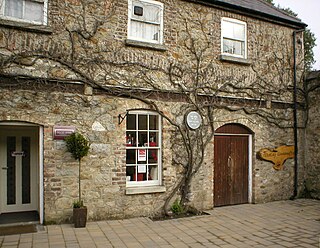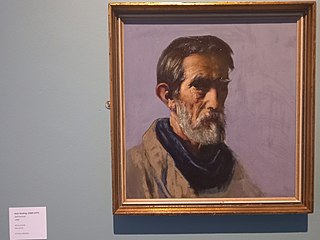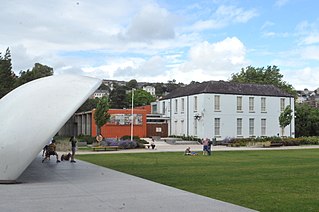
Theobald Mathew was an Irish Catholic priest and teetotalist reformer, popularly known as Father Mathew. He was born at Thomastown, near Golden, County Tipperary, on 10 October 1790, to James Mathew and his wife Anne, daughter of George Whyte, of Cappaghwhyte. Of the family of the Earls Landaff, he was a kinsman of the clergyman Arnold Mathew.

The 1873 Vienna World's Fair was the large world exposition that was held in 1873 in the Austria-Hungarian capital Vienna. Its motto was "Culture and Education".
Events from the year 1939 in Ireland.

Eva Sydney Hone RHA, usually known as Evie, was an Irish painter and stained glass artist. She is considered to be an early pioneer of cubism, although her best known works are stained glass. Her most notable pieces are the East Window in the Chapel at Eton College, which depicts the Crucifixion, and My Four Green Fields, which is now in the Government Buildings in Dublin.

Seán Keating was an Irish romantic-realist painter who painted some iconic images of the Irish War of Independence and of the early industrialization of Ireland. He spent two weeks or so each year during the late summer on the Aran Islands and his many portraits of island people depicted them as rugged heroic figures. However, he ceased to visit the Aran Islands in 1965.

Douglas is a suburb, with a village core, in Cork city, Ireland. Douglas is also the name of the townland, Roman Catholic parish, Church of Ireland parish and civil parish in which it is contained.

George Coppinger Ashlin was an Irish architect, particularly noted for his work on churches and cathedrals, and who became President of the Royal Institute of the Architects of Ireland.

Little Island, County Cork, is a civil parish and mainly industrial area to the east of Cork city in Ireland. It is no longer an island since the northern channel separating it from the mainland has filled over. To the west and south is Lough Mahon, part of Cork Harbour; across a channel to the east is Fota Island. Little Island is within the Dáil constituency of Cork North-Central.
The Mardyke is an area in Cork city, on the northern half of the long western part of the island formed by the two channels of the River Lee near the city centre. It was historically left as open space because the land along the north channel of the river is prone to flooding. From east to west these open spaces are: Presentation Brothers College, a boy's secondary school; the Mardyke ground of Cork County Cricket Club; Fitzgerald Park, which includes Cork Public Museum; Sunday's Well Lawn Tennis Club; and the athletic grounds of University College Cork.
Events from the year 1838 in Ireland.
William Atkins (c.1811–1887) was an Irish architect of the Victorian era. He was born in County Cork, and was reputedly apprenticed to architect George Richard Pain.
Hadji Bey is a Turkish delight confectionery that was originally produced in Cork and has since moved to a production site in County Kildare, Ireland with the successor to Urney Chocolates.

The Irish International Exhibition was a world's fair held in Dublin in 1907, when all of Ireland was still part of the United Kingdom.
Hamblin and Porter's School was a private school in South Mall, Cork City, Ireland. Its pupils came mainly from merchant classes and Church of Ireland backgrounds. Students pursued classical subjects, with many students matriculated at Trinity College Dublin.

Holy Trinity Church, also known as Father Mathew Memorial Church, is a Roman Catholic Gothic Revival church and friary on Fr. Mathew Quay, on the bank of the River Lee in Cork. It belongs to the Order of Friars Minor Capuchin and is the only church dedicated to Father Theobald Mathew.

The Mardyke, also referred as the Mardyke Sports Ground, is the main sports campus of University College Cork (UCC), located at the western end of the Mardyke area near Cork city centre. The grounds and fitness facilities used by sports team representing, the general student body, and members of the public. Outdoors, there are floodlit grass and all-weather pitches, used for soccer, rugby union, Gaelic games, and hockey. Kayakers train in the adjacent North channel of the River Lee. There is a tartan track for athletics, where the Cork City Sports are held annually. The most notable performance came in the hammer throw on 3 July 1984, when the world record was broken six times in one evening by Yuriy Sedykh and Sergey Litvinov.

Cork Public Museum is a city museum in Cork, Ireland. Housed in a mid-19th century building within Fitzgerald Park in the Mardyke area of the city, the museum's exhibits focus mainly on the history and archaeology of the Cork area.

Fitzgerald's Park or Fitzgerald Park is a public park in Cork city and the location of the Cork Public Museum. The park is located on the Mardyke and is a short distance from Cork city centre and University College Cork.
Cogar is an Irish television documentary series, shown on the Irish language channel TG4. It focuses on people who have been "ignored" or are at the margins of society.
Sir Edward J. Fitzgerald, 1st Baronet was an Irish politician. He spent several decades as a member of Cork Corporation and was the second Lord Mayor of Cork.














